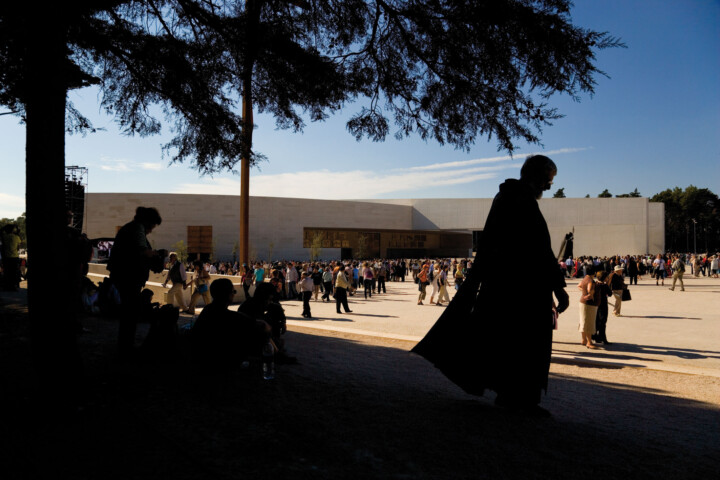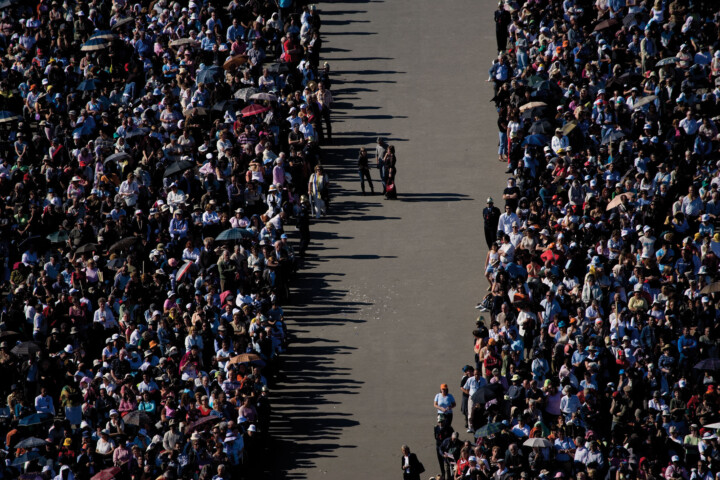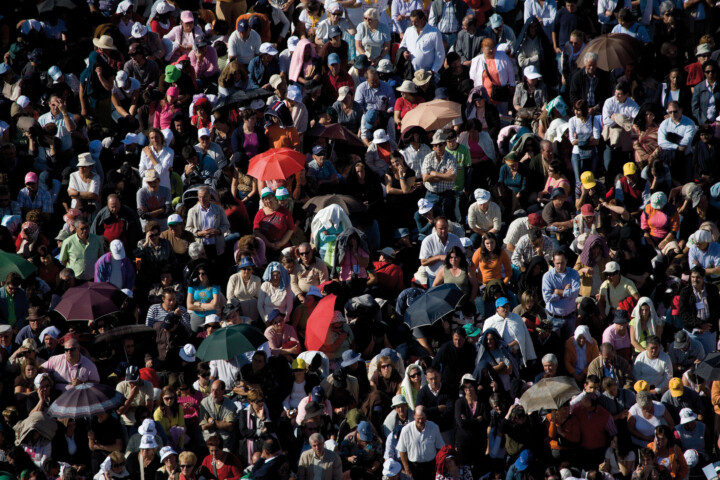The New Marian and Christian Fatima
José Barreto
Fátima is in transition and adapting to new times. As a place of repentance for the sins of the world and an emphasis on the redemptive role of suffering, the sanctuary is now no longer difficult to access and inadequately equipped to receive vast numbers of believers. In their comfortable and colorful clothes, today’s pilgrims also seem different from the poorly dressed villagers in the old photos, who endured hours of cold, rain and heat with the same perseverance and resignation as the daily sufferings of life. The current images of groups of pilgrims, equipped with tennis shoes, athletic clothing, and a bottle of water in hand, on their way to Fatima are more reminiscent of a marathon of faith. At the end of the pilgrimage, a roof over their heads and the hope of a seat inside the Church of the Holy Trinity already awaits them. The relationship of Fatima to penance is about to change. Suffering is more of a thing of the past.
Fátima’s current sacred art also equally reflects an adaptation to contemporary times. The modern and functional lines of the new church of Fatima, its architecture oriented towards the earth rather than towards the sky, the new white statue of the Virgin Mary inside, which has dropped some of the attributes of its traditional appearance, and the avant-garde steel shape of the Great Cross clearly testify to an aesthetic innovation of the sanctuary. Since the entire ancient part of the sacred site has been preserved, a general impression of diversity and plurality is created.
Fátima is not only changing its physiognomy, but will also adapt religiously, although this may be less obvious. New interpretations of the “mystery” of Fatima may point to horizons other than the traditional ones, without losing the apocalyptic character of the message of the Virgin Mary. The spiritual and mental universe of Fátima is still determined by the traditional ideas of sin, divine punishment, repentance and conversion, which are to be understood in the context of a cosmic struggle between the good and the corrupting forces above or beyond the actual history of mankind. However, the main theme of repentance can also be interpreted as a “dramatic appeal to man’s freedom to change himself and thus the course of history” (Cardinal Ratzinger, 2000). Fátima’s message, therefore, promises to multiply spiritually and to open itself to new symbolism, new teleologies and worldviews, some of which are in tension or conflict with the others. The unified image of a traditionalist, extremist and anti-ecumenical Fátima, historically characterized by an anti-Republican and – globally – anti-Communist attitude, is probably on the wane, without being replaced by another unified image. Since the 2nd Vatican Council, Fatima has been the subject and the scene of tensions and disputes between different tendencies, which correspond to some extent to the real pluralism of Catholicism in Portugal and worldwide. The extremist and anti-ecumenical Catholics wanted to make Fatima a symbolic fortress of their attitudes; the ecclesiastical leadership has rejected and prevented this connection in the last decades, so that Fatima is becoming an obstacle in the process of rapprochement between Christians and the dialogue between the Christian religion and other religions.
Fátima’s guiding idea of “converting Russia,” formulated before the rise of communism, is one of the points that has complicated the rapprochement between Roman Catholics and Eastern Christians. Even Marian devotion, for which Fatima is one of the international centers, is considered by some to be one of the greatest obstacles to Christian reunification. In a sense, Fatima has always been a place of confrontation, convergence or conflict for different religious views and attitudes. This was noticeable right at the beginning in the confrontation between the faith of the common people and the Catholic doctrine of the faith – that is, between the concrete beliefs and practices of the visionaries, adorers and pilgrims who shaped (and are shaping) Fatima, and the official attitude of the Church, which from the beginning has tried to incorporate, regulate, purify and determine the direction of the popular cult. At Fatima, as well as in a number of other apparitions and Marian devotions around the world, anthropologists have looked at how different understandings and strategies resist, converge, and interact in a process of negotiation and mutual influence.
Therefore, it cannot simply be claimed that Fatima “imposed itself on the Church” – which was and continues to be the version of the Catholic leadership – or that the Church invented Fatima. The truth probably lies somewhere between the two assertions. For popular faith does not arise out of nothing, nor is it “pagan”: often so-called popular manifestations of faith reflect themes, theses, and polemics that come directly from the inner circles of the official church.
This complex origin is especially evident in the confrontation of Fátima’s “popular” devotion to Mary with the doctrine of Christ’s omnipotence or divinity revealed in the Gospel and preached by the Church. Theologians and Catholic leaders assert that these are not two competing issues or two incompatible dimensions, either in Fatima or in the Catholic Church. It is a fact that all the popes of the 20th century were “devotees of Mary” and that today’s devotion to Mary is mainly due to their commitment. It was Pius XI, Pius XII, Paul VI and John Paul II who took up and promoted Fatima and other Marian devotion sites. One can justify the popular devotion to Mary, practiced predominantly by women, with various psychological or sociological theories; it may even have to do with the rise of women in society as well as the recognition of their role in the Church. However, it cannot be said that, as far as Church doctrine is concerned, it originated on the margins of the Church. John Paul II is said to have been on the verge of issuing a new Marian dogma that would have given Mary the role of “Coredemptrix,” thus bringing her somewhat closer to the level of Savior and divinity. Only the fear that this would increase the separation from the Protestants had probably prevented him from doing so.
Now it seems that in the Shrine of Fátima a just balance is sought between the hitherto dominant Marian references and what is, or should be, the central theme of Christianity: Jesus Christ. The attempt to restore the correct proportions of the symbolic representations in the sanctuary is suggested by the central position of the strongly offset, large crucifix at the altar of the new church and by the conspicuousness of the imposing Great Cross near the main entrance.
The outdoor cross, with its airy lightness of fifty tons of rust-colored steel, not only serves as a Christian landmark for a church with an almost agnostic orientation and for the entire sanctuary, but it also looks to the century that has begun and to all those yet to follow. The Great Cross, a remarkable work by the sculptor Robert Schad, embodies very well the symbol of the meeting with the future that Fatima seeks.





